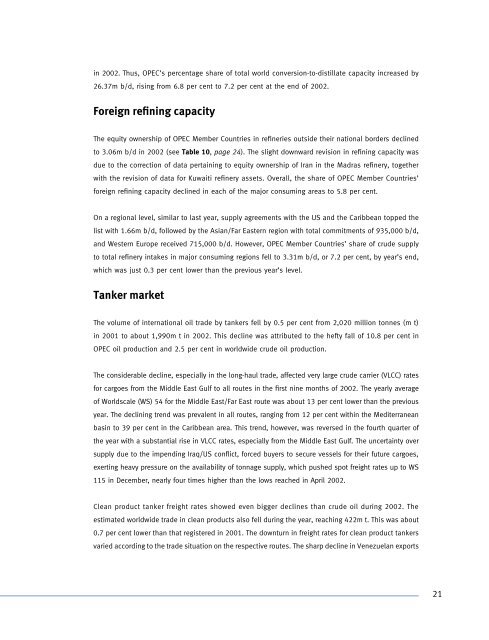2002 - OPEC
2002 - OPEC
2002 - OPEC
You also want an ePaper? Increase the reach of your titles
YUMPU automatically turns print PDFs into web optimized ePapers that Google loves.
in <strong>2002</strong>. Thus, <strong>OPEC</strong>’s percentage share of total world conversion-to-distillate capacity increased by<br />
26.37m b/d, rising from 6.8 per cent to 7.2 per cent at the end of <strong>2002</strong>.<br />
Foreign refining capacity<br />
The equity ownership of <strong>OPEC</strong> Member Countries in refineries outside their national borders declined<br />
to 3.06m b/d in <strong>2002</strong> (see Table 10, page 24). The slight downward revision in refining capacity was<br />
due to the correction of data pertaining to equity ownership of Iran in the Madras refinery, together<br />
with the revision of data for Kuwaiti refinery assets. Overall, the share of <strong>OPEC</strong> Member Countries’<br />
foreign refining capacity declined in each of the major consuming areas to 5.8 per cent.<br />
On a regional level, similar to last year, supply agreements with the US and the Caribbean topped the<br />
list with 1.66m b/d, followed by the Asian/Far Eastern region with total commitments of 935,000 b/d,<br />
and Western Europe received 715,000 b/d. However, <strong>OPEC</strong> Member Countries’ share of crude supply<br />
to total refinery intakes in major consuming regions fell to 3.31m b/d, or 7.2 per cent, by year’s end,<br />
which was just 0.3 per cent lower than the previous year’s level.<br />
Tanker market<br />
The volume of international oil trade by tankers fell by 0.5 per cent from 2,020 million tonnes (m t)<br />
in 2001 to about 1,990m t in <strong>2002</strong>. This decline was attributed to the hefty fall of 10.8 per cent in<br />
<strong>OPEC</strong> oil production and 2.5 per cent in worldwide crude oil production.<br />
The considerable decline, especially in the long-haul trade, affected very large crude carrier (VLCC) rates<br />
for cargoes from the Middle East Gulf to all routes in the first nine months of <strong>2002</strong>. The yearly average<br />
of Worldscale (WS) 54 for the Middle East/Far East route was about 13 per cent lower than the previous<br />
year. The declining trend was prevalent in all routes, ranging from 12 per cent within the Mediterranean<br />
basin to 39 per cent in the Caribbean area. This trend, however, was reversed in the fourth quarter of<br />
the year with a substantial rise in VLCC rates, especially from the Middle East Gulf. The uncertainty over<br />
supply due to the impending Iraq/US conflict, forced buyers to secure vessels for their future cargoes,<br />
exerting heavy pressure on the availability of tonnage supply, which pushed spot freight rates up to WS<br />
115 in December, nearly four times higher than the lows reached in April <strong>2002</strong>.<br />
Clean product tanker freight rates showed even bigger declines than crude oil during <strong>2002</strong>. The<br />
estimated worldwide trade in clean products also fell during the year, reaching 422m t. This was about<br />
0.7 per cent lower than that registered in 2001. The downturn in freight rates for clean product tankers<br />
varied according to the trade situation on the respective routes. The sharp decline in Venezuelan exports<br />
21
















